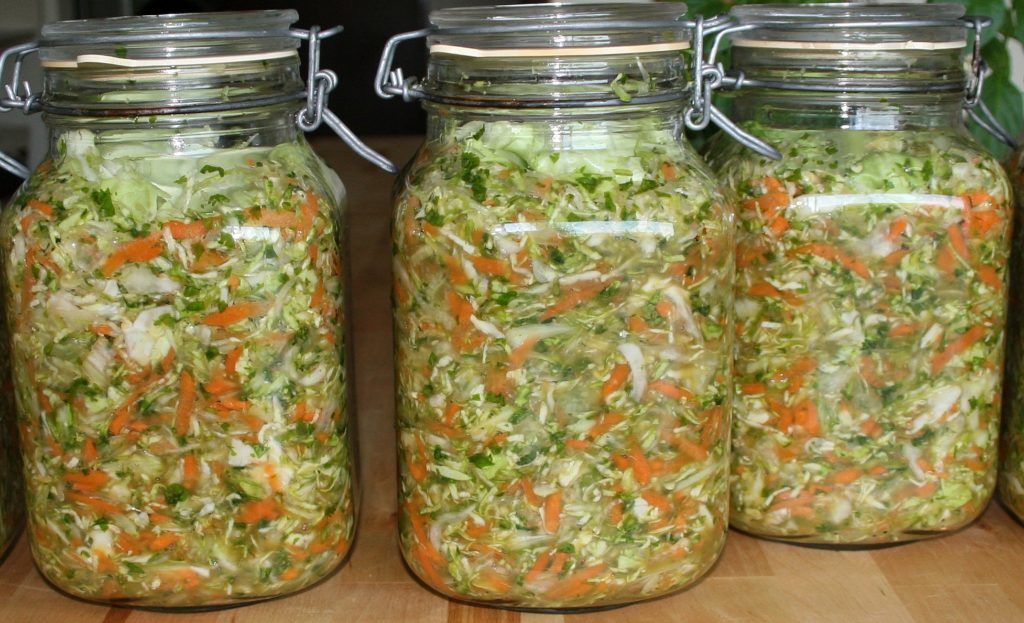Preparing sauerkraut at home is simple and straightforward, not to mention cheap and delicious. This recipe is a variation of the classic sauerkraut recipe—no sugar or vinegar is used. Preparing sauerkraut is great for beginners.
How to prepare sauerkraut
Here I used green cabbage which is cheap and simple to ferment. Try adding red cabbage which adds a beautiful color. Cabbage has a lovely, fresh, crunchy taste when fermented. Please feel free to add greens, seeds, herbs, and other vegetables if you like.
This particular recipe calls for caraway seeds, which I learned to enjoy in Eastern Europe where fermented cabbage is very popular.
Here are a few tips:
- Organic: I think organic cabbage is best, though you can of course use any cabbage. Rinse the veggies thoroughly in water.
- Salt: Traditionally, much salt is used when fermenting cabbage. Salt protects the veggies and makes them crunchier. A concentration of 2-2.5 % is considered normal, though I often use less. In this recipe, I added a few tablespoons.
- Starter culture: Body Ecology makes good ones. A starter makes fermentation stable, more predictable, and adds more bacteria.
1. Prepare the starter culture
If you have a juicer, mix the starter culture with fresh celery juice. Otherwise, follow the instruction on the package (using water).
Let the juice sit while shredding the veggies. celery juice adds a nice flavour and helps protect the vegetables.
2. Shred the cabbage
Green cabbage is the backbone of the veggie blend. You can also add a few carrots, a sweet potato, parsley, ginger, or coriander leaves. A little red cabbage makes the mix beautiful.
When preparing a small batch shredding by hand is okay. But for bigger batches it’s much easier to use a food processor.
3. Mix starter juice and veggies
Pour the juice starter culture over the vegetables and mix well. Use your hands or some tool to squeeze. Squeezing, pressing and beating the veggies a few minutes is enough.
This is also a good time to add sea salt. Around one tablespoons per quart of veggies is normal.
4. Fill the jars
Pack the veggies in the jars to remove air; this promotes fermentation. Don’t fill the jar completely full but leave some 20% empty. Fermentation produces gas and makes the brine bubble and rise.
If needed, add more liquid to keep the veggies submerged. Here I added filtered water with a little salt as I did not have any more celery juice. And lastly, add a cabbage leaf on top to help keep the vegetables in the brine.
5. Ferment at room temperature
It normally takes two or three days for fermentation to reach a peak. Gas is produced causing brine to leak out. This is normal. Put the jars where you can easily clean up like a kitchen sink or bath tub.
How long should the jars ferment at room temperature? Between 7-12 days. Fermenting in a warm climate might be faster and in a cooler climate a bity slower. Taste to determine when it’s ready.
NOTE: Don’t put the lids on too tight to let gas escape. You can also open the lid for a second each day to let gas out. If you use jars with a rubber seal as I do here, you don’t need to do anything.
6. Store in a cool place
When fermentation is complete, store the jars in a cool place like a basement or a fridge. Fermentation will continue but at a slow pace. The living culture in the jars will stay fresh for a long time, at least several months. But in our home, the sauerkraut never lasts long!
7. Enjoy!
The taste of successfully fermented sauerkraut should be tart and refreshing and the veggies crunchy. Studies show that a few tablespoons of homemade sauerkraut can contain more probiotic bacteria than a gallon of yogurt.
What does sauerkraut contain?
- A mixture of gases, mostly carbon dioxide
- A mixture of aromatic esters
- Probiotic bacteria
- Propionic acids
- Acetic acid
- Lactic acid
- Enzymes
- Vitamins
- Alcohol
These contribute to the characteristic flavor of sauerkraut. The acidity contributes to a long shelf life.
Fermentation problems
When preparing sauerkraut at home, most problems occur due to the presence of unwanted microorganisms. These creatures break down protein and produce undesirable flavor and a mushy texture.
The sauerkraut is too soft
If the fermentation process is disturbed, it can results in soft or mushy vegetables. These are common reasons:
- Too much oxygen in jars
- Too little salt added
- Too warm
Dark colored vegetables
This can occur because of bad microorganisms like mold. Good hygiene is important; be sure jars and utensils are clean. Make sure that the vegetables are covered by brine and that no oxygen is allowed into the jar. If your room temperature is high you need to let the jars ferment in a cool place to avoid undesirable microorganisms.
Sauerkraut with pink color
A pinkish color can be caused by a group of yeasts that produce an intense red pigment in the juice and on the cabbage surface. This seems to be more common in wild fermentation without the use of a culture starter. Another reason is an excessive concentration of salt. Always use a culture starter to minimizes the risk.
Preparing sauerkraut at home is a fascinating cooperation between you and billions of friendly bacteria.
